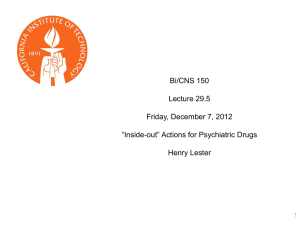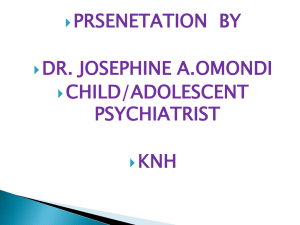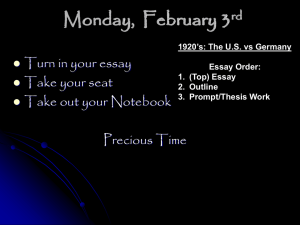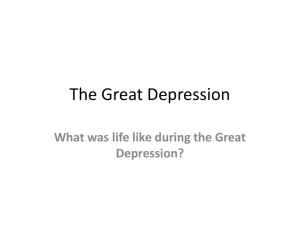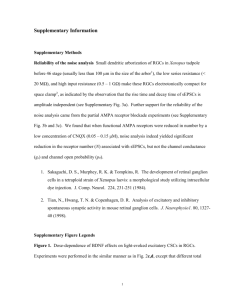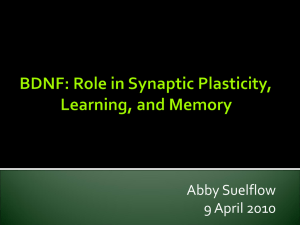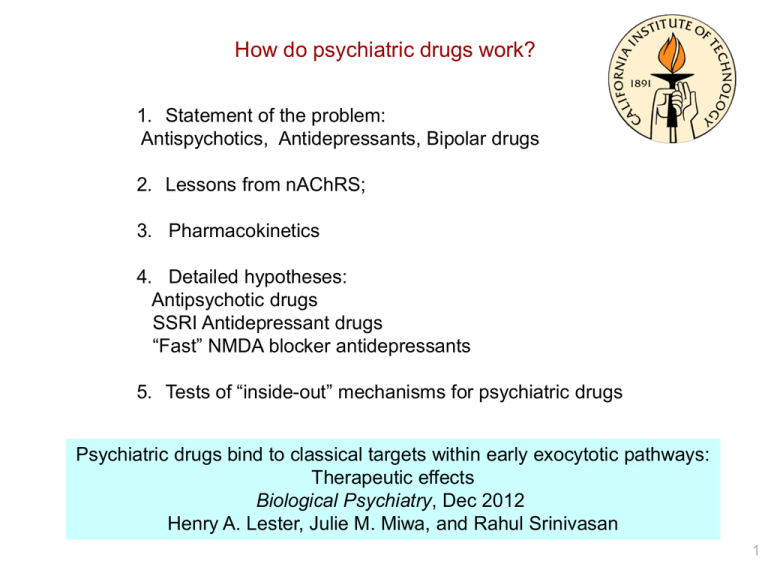
How do psychiatric drugs work?
1. Statement of the problem:
Antispychotics, Antidepressants, Bipolar drugs
2. Lessons from nAChRS;
3. Pharmacokinetics
4. Detailed hypotheses:
Antipsychotic drugs
SSRI Antidepressant drugs
“Fast” NMDA blocker antidepressants
5. Tests of “inside-out” mechanisms for psychiatric drugs
Psychiatric drugs bind to classical targets within early exocytotic pathways:
Therapeutic effects
Biological Psychiatry, Dec 2012
Henry A. Lester, Julie M. Miwa, and Rahul Srinivasan
1
Disclaimer
This session deals with psychiatric disease.
Henry Lester is not a psychiatrist--not even a physician.
Don’t change any medical treatment that you might now be receiving on the basis of
these lectures.
Don’t give any medical advice based on these lectures or problem sets.
2
Disease Burden by Illness - Disability Adjusted Life Years
United States, Canada and Western Europe, 2000
15-44 year olds
Unipolar depressive disorders
Alcohol use disorders
Schizophrenia
Iron-deficiency anemia
Bipolar affective disorder
Hearing loss, adult onset
HIV/AIDS
Chronic OPD
Osteoarthritis
Road traffic accidents
00
22
44
6
6
88
Percent of Total
Source: WHO – World Health Report, 2001
10
10
16
12
How do psychiatric drugs work?
1. “The mood-elevating effects of fluoxetine [Prozac] are not evident after initial
exposure to the drug but require its continued use for several weeks. This
delayed effect suggests that it is not the inhibition of serotonin transporters per
se, but some adaptation to sustained increases in serotonin function that
mediates the clinical actions of fluoxetine. However, where these adaptations
occur in the brain, and the nature of the adaptations at the molecular level, have
yet to be identified with certainty.”
2. “All current antipsychotic drugs exert their full therapeutic actions over weeks,
suggesting that, like lithium and antidepressants, slowly developing adaptations
(in this case to initial D2 dopamine receptor blockade) are required for their
antipsychotic effects.”
S. E. Hyman, E. Nestler, R. Malenka, 2008
Molecular Neuropharmacology : A Foundation for Clinical Neuroscience, 2nd Edition
4
Some psychiatric drugs, their targets,
logP values, and half lives
antipschizophrenic
recreational /
abused / addictive
chlorpromazine
(Thorazine)
dopamine D2 receptor, GPCR
logP 5.2, 16-30 hr
antidepressant
ketamine
(“special K”)
NMDA glutamate receptor
logP 2.2, 3-5 hr
nicotine
acetylcholine receptor
logP 1.2, 0.5 -2 hr
clozapine (Clozaril)
5-HT2A serotonin receptor, GPCR
logP 3.2, 8-12 hr
fluoxetine
(Prozac)
serotonin transporter
logP 3.4, 24-72 hr
5
Schizophrenia Pathophysiology
thousands
Each “advance” in biology has been tried out on schizophrenia.
Early 20th century, German classification & Nazi genetics
1950’s American psychiatrists (including Bettelheim) reacted with “schizogenic mother”
or “refrigerator mother” hypothesis
1950, Linus Pauling fractionated urine; 1968 “Orthomolecular Psychiatry” in Science
1955, chlorpromazine dopamine theories
Population of US Public Mental Insitutions
1970, glutamate theories
600
1995, growth factors, development, migration
500
2000, genetics & genomics
400
300
2003, interneuron diversity
200
2005, inflammation
100
There is no satisfactory explanation yet.
0
1800
1850
1900
1950
2000
2050
year
In general, modern theories of schizophrenia emphasize abnormal balance among
neuronal circuits or pathways, rather than individual neurons that either
(a) degenerate or
(b) fire too much or too little
6
Clinical potency of
“classical” or “typical”
antipsychotic drugs
correlates best
with
dopamine D2 receptor
blocking dose
(Nestler, 16-6)
7
Clinical potency of “classical” or “typical” antipsychotic drugs
correlates with dopamine D2 receptor blocking dose . . .
. . . . but modern “atypical” antipsychotics also block other GPCRs (Nestler, 16-8)
Haloperidol
Clozapine
Quetiapine
Affinity
D1 dopaminergic
D2 &D3 dopaminergic
Muscarinic cholinergic
5HT2A serotonergic
Risperidone
Olanzapine
Sertindole
α1 adrenergic
α2 adrenergic
H1 histaminergic
Terrible side effects:
Conventionals:
tardive dyskinesia (mesostriatal pathway)
Atypicals:
weight gain, agranulocytosis
8
Major Depression
I.
Symptoms: Depression is defined as the affective state of sadness that
occurs in response to a variety of human situations such as loss of a loved
one, failure to achieve goals, or disappointment in love. Major depression
differs only in intensity and duration or quality of the emotional state.
(“Anhedonia”)
From Berton and Nestler, Nature Reviews
Neuroscience, 7: 137, 2006
II. Characteristics of Major Depression
A.
Untreated episodes of major depression usually last from 7 - 14
months.
B.
Major depression is a recurring disorder, usually worsening with
age if not treated.
C.
The reported incidence of depression is 3 times higher in
women than in men.
Depression involves dysfunction of many brain areas
Along with changes in mood, the symptoms of Major Depression include
disruption of basic drives (eating and sleeping), as well as cognitive
disturbances (ruminations, guilt, indecisiveness, persistent thoughts of
suicide).
This constellation of symptoms suggest involvement of cortical
structures, a number of limbic brain structures, including the hippocampus,
amygdala, and mesolimbic dopamine neurons (“reward centers”), and also
midbrain structures controlling appetite.
Brain Areas that Regulate Mood
FC: Frontal cortex (esp. prefrontal and
cingulate) - cognitive function, attention
HP: Ventral Hippocampus - cognitive
function, memory
NAc: Nucleus Accumbens (ventral
striatum) - reward and aversion
Amy: Amygdala - mediates responses
to emotional stimuli
HYP: Hypothalamus regulates sleep,
appetite, energy, sex
VTA: Ventral Tegmental Area - Sends
dopaminergic projections to other
areas
DR: Dorsal Raphe nuclei - send
serotonergic input to other areas
LC: Locus Coeruleus - sends
noradrenergic input to other areas.
From Berton and Nestler, Nature
Reviews Neuroscience, 7: 137, 2006
SSRI’s
I.
II.
III.
IV.
The most successful medicines for treatment of Major Depression in
recent years have been the selective serotonin reuptake inhibitors
(SSRI’s)
SSRI’s include Prozac, Zoloft, Celexa, Paxil… These drugs inhibit
the specific serotonin transporters that take up serotonin after it is
released. Thus, the drugs are believed to increase serotonin levels
in the brain.
Depression also is accompanied by misregulation of other
neurohormonal pathways, for example the ACTH (pituitary) /cortisol
(adrenal gland) pathway. NE and DA systems may also be
misregulated.
The SSRI’s are not effective for about half of cases of depression.
Thus, we have much more to learn about the various causes of
depression.
Serotonergic systems in the brain
Rostral System
Caudal System
The midbrain Raphe nuclei
from Feldman et al., Principles of Neuropsychopharmacology, Sinauer, 1997
Rostral System
B6 and B7 are the Dorsal Raphe
nuclei, which contain 5-HT
neurons whose endings branch
profusely and do not make
“conventional” synapses. This
fiber system is called the Dsystem.
B5 and B8 are the Median Raphe
nuclei, which contain 5-HT
neurons whose endings form
repeated, more conventional
synapses. This fiber system is
called the M system.
B9 is also called the
supralemniscal nucleus (SLN).
from Feldman et al., Principles of Neuropsychopharmacology, Sinauer, 1997
Two Serotonergic Fiber Types in the Forebrain Demonstrated by
Immunocytochemical Labeling
D-System - small arrows
M-System - large arrows
Scale bar = 10 µm
from Tork, Ann. N.Y. Acad. Sci., 1990
Bipolar Disease
1. Clinical description
2. Genetics
3. Possible causes
4. Heterozygote advantage?
5. Therapeutic approaches
17
1. Clinical description, based on DSM-IV.
Bipolar disorder affects 1-1.5% of the
population in most modern societies.
Like depression, bipolar disorder is a
mood disorder. It was formerly termed
manic-depressive disorder, because
patients have one or more manic or nearly
manic episodes, alternating with major
depressive episodes.
1st episode often in mid-20’s.
Bipolar disorder often leads to suicide.
18
From DSM-IV
Summary description of a manic episode
Manic Episode is defined by a distinct period during which there is an abnormally and
persistently elevated, expansive, or irritable mood. This period of abnormal mood
must last at least 1 week (or less if hospitalization is required).
The mood disturbance must be accompanied by at least three additional symptoms
from this list:
-inflated self-esteem or grandiosity,
-decreased need for sleep,
-pressure of speech,
-flight of ideas,
-distractibility,
-increased involvement in goal-directed activities or psychomotor agitation, and
Excessive involvement in pleasurable activities with likelihood of painful
consequences
If the mood is irritable (rather than elevated or expansive), at least four of the above
symptoms must be present . . . .
The disturbance must be sufficiently severe to cause marked impairment in social or
occupational functioning or to require hospitalization, or it is characterized by the
presence of psychotic features . . . . .
19
2. Genetics
No single gene causes bipolar disorder.
Data for concordance among twins in bipolar disorder:
“narrow”
definition
“broad”
definition
monozygotic
(n = 55)
79%
97%
monozygotic,
reared apart
(n = 12)
69%
dizygotic
(n = 52)
24%
38%
20
3. Possible causes of bipolar disease
Each new advance in neuroscience has been tried out on bipolar disorder-as for schizophrenia.
There is no satisfactory explanation yet.
As for schizophrenia, present theories invoke:
circuit properties
early developmental events
rather than individual neurotransmitter systems.
21
4. Heterozygote advantage?
Touched With Fire : Manic Depressive Illness and the Artistic Temperament
by Kay Redfield Jamison
"This is meant to be an illustrative rather than a comprehensive list . . .Most of the
writers, composers, and artists are American, British, European, Irish, or Russian; all
are deceased . . . Many if not most of these writers, artists, and composers had other
major problems as well, such as medical illnesses, alcoholism or drug addiction, or
exceptionally difficult life circumstances. They are listed here as having suffered from
a mood disorder because their mood symptoms predated their other conditions,
because the nature and course of their mood and behavior symptoms were
consistent with a diagnosis of an independently existing affective illness, and/or
because their family histories of depression, manic-depressive illness, and suicide-coupled with their own symptoms--were sufficiently strong to warrant their inclusion."
autobiography:
An Unquiet Mind
by Kay Redfield Jamison
22
from Jamison
KEY:
H= Asylum or psychiatric hospital;
S= Suicide;
SA = Suicide Attempt
Writers Hans Christian Andersen, Honore de Balzac, James Barrie, William Faulkner (H), F. Scott
Fitzgerald (H), Ernest Hemingway (H, S), Hermann Hesse (H, SA), Henrik Ibsen, Henry James,
William James, Samuel Clemens (Mark Twain), Joseph Conrad (SA), Charles Dickens, Isak
Dinesen (SA), Ralph Waldo Emerson, Herman Melville, Eugene O'Neill (H, SA), Mary Shelley,
Robert Louis Stevenson, Leo Tolstoy, Tennessee Williams (H), Mary Wollstonecraft (SA), Virginia
Woolf (H, S)
Composers Hector Berlioz (SA), Anton Bruckner (H), George Frederic Handel, Gustav Holst,
Charles Ives, Gustav Mahler, Modest Mussorgsky, Sergey Rachmaninoff, Giocchino Rossini,
Robert Schumann (H, SA), Alexander Scriabin, Peter Tchaikovsky
Nonclassical composers and musicians Irving Berlin (H), Noel Coward, Stephen Foster,
Charles Mingus (H), Charles Parker (H, SA), Cole Porter (H)
Poets William Blake, Robert Burns, George Gordon, Lord Byron, Samuel Taylor Coleridge, Hart
Crane (S) , Emily Dickinson, T.S. Eliot (H), Oliver Goldsmith, Gerard Manley Hopkins, Victor Hugo,
Samuel Johnson, John Keats, Vachel Lindsay (S), James Russell Lowell, Robert Lowell (H), Edna
St. Vincent Millay (H), Boris Pasternak (H), Sylvia Plath (H, S), Edgar Allan Poe (SA), Ezra Pound
(H), Anne Sexton (H, S), Percy Bysshe Shelley (SA), Alfred, Lord Tennyson, Dylan Thomas, Walt
Whitman
Artists Richard Dadd (H), Thomas Eakins, Paul Gauguin (SA), Vincent van Gogh (H, S), Ernst
Ludwig Kirchner (H, S), Edward Lear, Michelangelo, Edvard Meunch (H), Georgia O'Keeffe (H),
George Romney, Dante Gabriel Rossetti (SA)
23
People with bipolar disorder are often fascinating in the early stages.
24
Vincent Van Gogh 1853-1890
750 paintings;
1600 drawings;
700 letters
Life history: born and raised in the Netherlands
Paris 1886-88
Arles 1888 (1st episode; cut off his own ear)
hospitalized 1888-1890
Auvers-sur-Oise 3 months. Shot himself 7/27/1890
1886
1887
1887-88
25
I should like to do portraits which will appear as
revelations to people in a hundred years' time.
-- Letter to his sister Wil, 3 June 1890
Dr. Gachet
June 1890
Early 1889
26
July 1890
27
28
29
5. Therapeutic approaches to bipolar disorder
Surgical and electrical intervention
Surgery to remove large portions of the brain (1950’s-60’s)
Electroconvulsive shock therapy (ECT).
Now administered under anesthesia.
Various electrode placements, pulse widths, and frequencies
“In situations where medication, psychotherapy, and the combination of these
interventions prove ineffective, or work too slowly to relieve severe symptoms
such as psychosis (e.g., hallucinations, delusional thinking) or suicidality,
electroconvulsive therapy (ECT) may be considered. ECT is a highly effective
treatment for severe depressive episodes.“
-- National Institute of Mental Health
Over a hundred theories have been offered to account for the efficacy of ECT.
http://www.acnp.org/G4/GN401000108/CH106.html
30
Therapeutic approaches to bipolar disorder
Drugs
(upper left-hand region
of the periodic table)
Li+ ion
Therapeutic effects begin in ~ 5 d, require several wk.
Li+ is quite poisonous at higher doses.
Valproic acid and other anticonvulsants
These also require several wk for full effects.
31
Three exemplar patients in the early days of Li+
How does Li+ act?
1. We don’t know, but there are now some good guesses.
2.
All ideas about Li+ assume an intracellular target.
Li+ enters cells freely through several channels and ion-coupled transporters
that normally serve for Na+.
Intracellular concentrations of Li+ are probably several mM.
3.
Most ideas about Li+ involve enzyme inhibition.
Most of the suspected enzymes manipulate high-energy phosphate bonds.
32
Contemporary ideas about psychiatric drugs
have emphasized binding to
the classical targets at synapses. . .
“Inside-out” mechanisms emphasize binding to
the same classical targets, but within the
endoplasmic reticulum and cis-Golgi
Like most drugs, nicotine is a weak base.
Its neutral form passes through 6 plasma membranes in ~ 20 s
Alvelolar
epithelium
Lungs
Brain capillary
Blood
CSF
H+
logP = 1.1 = log (solubility in octanol / water)
34
“Inside-out” Drug Action by Nicotine at α4β2 nAChRs
Na+
Classical Pathway:
Channel activation
& desensitization
nAChR
Plasma
membrane
Ca2+
Clathrin
Secretory
vesicle
Early
endosome
Golgi
COPI
Nicotine in CSF
ATF6
Lysosome
Golgi
complex
COPII vesicle
Sec 13/31
COPI
ATF6
Pharmacological
Chaperoning→
upregulation
COPII
Sec24
Sec23
Endoplasmic
reticulum
Sar1
PERK
IRE1 nAChR
M3-M4 loop
Unfolded protein response
→ Do neurons survive
Despite stressors?
ATF4
eIF2α
+
XBP1
H+
UPRE
BiP
ER
Nucleus
IRE1
PERK
35
Three possible results of nicotine-nAChR binding in the endoplasmic reticulum
1. Agonist binding eventually favors stable,
high-affinity states (a “chaperone”)
unbound
agonist
2. Nicotine binding at subunit interface favors
assembled nAChRs (a “matchmaker”)
Bound states with
increasing affinity
nicotine
20 sec
Free Energy
106
channels
“closed”
AC
“activated”
Highest
affinity
?
“desensitized”
Reaction Coordinate
3. Nicotine may displace lynx, directing nAChRs toward cholesterol-poor domains (an “escort”)
nicotine
lynx
36
The three arms of the ER stress / unfolded protein response pathway
R. L. Wiseman, C. M. Haynes, D. Ron Cell 2010
37
Inside-out Pharmacology of Nicotine Effects at α4β2 nAChRs
During chronic exposure to nicotine, α4β2 nAChRs are selectively upregulated.
Now we’re assessing gene expression in identified neurons chronically
exposed to nicotine.
Pharmacological chaperoning is necessary but not sufficient for upregulation.
Upregulation proceeds similarly in clonal cells, rodent brains, and smokers’ brains.
Other sequelae of chaperoning: changed stoichiometry, reduced ER stress and
reduced UPR.
Inside-out pharmacology is a powerful concept for nearly all CNS drugs:
They are all membrane-permeant weak bases.
38
The discovery criteria for psychiatric drugs lead to excellent intracellular chaperoning
1. High bioavailability implies high membrane permeation
All psychiatric drugs have logP > 2
2. Good stability in the body implies simple or little enzymatic breakdown.
Half-life is ~ 1 day.
3. Good selectivity, few off-target effects imply high-affinity binding to the target
Kd < 1 μM, often ~ 10 nM
a. “Chaperoning”:
(i) Transporter ligands are
organic substrates
ions,
or antagonists,
They favor two major binding states, “inward” vs “outward”.
(ii) GPCR ligands (see next slide):
agonists
antagonists
allosteric modulators
“inverse” agonists
b. “Matchmaking”:
(i) Neurotransmitter transporters must homodimerize before leaving the ER
(ii) GPCRs homo- and heterodimerize,
in some cases required for ER export,
in some cases favored by ligands
39
Pharmacological chaperoning of GPCRs
receptor
mutant /WT
drug class
reference
adenosine A1
mutant
agonists; antagonists
(Malaga-Dieguez et al., 2010)
dopamine D4
both
transported dopamine;
quinpirole; antagonists
gonadotropinreleasing hormone
mutant
antagonists
(Van Craenenbroeck et al.,
2005)
(Conn and Ulloa-Aguirre,
2011)
histamine H2
both
agonist, inverse agonist
(Alewijnse et al., 2000)
opsin
mutant
--
(Noorwez et al., 2008)
δ-opioid
mutant
antagonist
(Leskela et al., 2012)
μ-opioid
mutant
agonists, antagonists
(Chaipatikul et al., 2003)
mutant
antagonist
(Fan et al., 2005)
both
both
both
both
antagonist, inverse agonist
antagonist
antagonist
antagonists
(Tao, 2010)
(Hawtin, 2006)
(Robert et al., 2005)
(Wuller et al., 2004)
melanin conc.
hormone
melanocortin-4
vasopressin V1a
vasopressin V1b/V3
vasopressin V2
40
Two mechanisms for gene activation downstream from antipsychotic drugs
Most papers suggest . . .
βarrestin
Intracellular
messenger
bg
Enzyme
or
channel
ATF6
Drug+
in CSF
Golgi
H+
Neutral
permeant
drug
ATF6,
CREBH
Endoplasmic
reticulum
kinase
+
+
cascade
IRE1
PERK
+
a
Golgi
+
ATF4
p-eIF2α
Transcription
factors
XBP1
Nucleus
Transcription
factors
UPRE
+
+
+
In CSF
+
Drug+
B. Intracellular pharmacological
chaperoning of GPCR,
and downstream effects
+
A. Inhibition of plasma membrane GPCR ,
and downstream effects
We suggest . . .
H+
ER
BiP
IRE1
PERK
Nucleus
“Nearly” cell-autonomous actions of SSRI antidepressant treatment
Kellermann group
42
Adult Neurogenesis
Inside-out actions would occur here
Other diagrams
Samuels & Hen, Eur J. Neurosci, 2011
43
Gene activation is too brief to account for the “therapeutic lag”
Axonal transport provides a natural delay in the
“inside-out” mechanism.
Speed: ~ 1 mm / day.
Mouse hippocampus
Suggests that equivalent effects would require
briefer delays in animals with shorter axons
Marks et al, 1985
Days of nicotine infusion
Dendritically localized events
44
How does acute ketamine produce antidepressant effects within 2 hr?
(1) involve BDNF synthesis & release,
(3) require protein synthesis,
Monteggia & Duman groups suggest . . .
The effects
(2) occur in the dendrites,
(4) do not require gene activation.
We suggest . . .
Outside-in
NMDA Receptor
Inside-out
Ca2+
BDNF
secretion
BDNF
secretion
Decreased
Ca2+ flux
Dendritic
Golgi
Escorting
kinases↓
COPII
+
+
pPERK↓
+
+
BDNF↑
+
Dendritic
ER
BDNF↑
p-eIF2α↓
BDNF
mRNA
BDNF
mRNA
NMDA Receptor
+
H+
ER
BiP
IRE1
PERK
45
“Acid trapping” of nicotine might
1. keep nAChRs
desensitized until
they are exocytosed;
2. serve as a
reservoir for nicotine
nAChR
Cell
membrane
pH
nic+
nicCSF
5.2
100
6.0
30
6.3
20
6.5
10
6.7
3
7.2
1
7.2
1
Clathrin
Secretory
vesicle
Early
endosome
COPI
Lysosome
Golgi
complex
Nicotine in CSF
COPI
COPII
Endoplasmic
reticulum
nAChR
&
See detailed calculations
for antipsychotics:
Tischbirek et al,
Neuron 2012
What knowledge do we need next?
As usual, we need cell biology & biochemistry
1. Reconstituted, cell-free systems for ER exit and retrieval
2. Better real-time markers for compartmentalized receptors and transporters
a. Imaging mass spectrometry
b. Plasma membrane binding only? Possible with impermeant derivatives
c. ER binding only? More challenging, especially for antagonists.
3. Better measurements of pathway-specific gene activation (RNA-Seq)
4. Analyze newly synthesized proteins
47
Contemporary ideas about psychiatric diseases
have emphasized synaptic and signaling deficits . . .
“Inside-out” mechanisms emphasize that
~30% of a cell’s proteins enter the ER,
and additional nuclear and cytoplasmic proteins
control their synthesis & trafficking.
Three concepts used in describing complex diseases such a schizophrenia
Polygenic
the disease occurs only if several genotypes are present together
Genetically Multifactorial
several distinct genes (or sets of genotypes) can independently cause the disease
Partially penetrant
nongenetic or epigenetic factors are required, or the disease is inherently stochastic
Genetically
Multifactorial
Polygenic
Partially
Penetrant
49
Genetics
shared DNA
100%
Concordance for Lifetime Risk of Schizophrenia
identical twins
48%
17%
fraternal twins
50%
(1st-degree
relatives)
(David Helfgott’s father; John Nash’s son)
children
siblings
parents
half siblings
grandchildren
25%
nephews/nieces
uncles/aunts
12.5%
1st cousins
general population
0%
1% (independent of culture)
10%
20%
30%
40%
Like Kandel Figure 60-3
50%
50
GABAergic “chandelier cell”
in human cerebral cortex has
many large axon terminals . . .
. . . and plentiful somatic ER
Ch
axon
Ch
Chterminals
terminals
Pyramidal
Cells
~ 100 μm
DeFelipe, Brain (1999) 122, 1807 (Cajal Institute, Madrid)
Jones, J. Comp. Neurol., 1984 51
End of session
52

